|
observer |
|
|
|
|
|
OTHER LINKS |

|

|

|
What passes for architecture, post- Bawa
Living monumentThe garden, not much changed structurally, consists of well-laid out terraces that is a living monument to Bawa's creativity. It was Bawa's cousin who persuaded him to formalise his leisure whereby he could continue to enjoy it, but with others' money and that initiated his career as an architect. The hallmark of Bawa's architecture is its intrinsic simplicity and his effortless ability to integrate natural objects such as boulder into his creations. The Kandalama hotel and Estate Bungalow Polontalawa are some of his works where natural obstacles were ingenuously integrated into his formations. The history of the contemporary architectures in Sri Lanka goes back to 1916. It was the kind of architecture that was distinctly different from colonial architecture with an understanding of tradition. The singular contribution that Bawa made to Sri Lankan architecture was that he upgraded this traditional architecture to international standards. 'Modern movement'However, another tendency in the contemporary Sri Lankan architecture is the 'modern movement' where buildings were constructed in international motif. The prominent shortcoming in this form of architecture is that it was climatically unsuitable for Sri Lanka and is often unsuitable for Sri Lankan lifestyles. One of the pioneer proponents of this movement was Valentine Gunasekara. The 'problem solving movement' is aimed on the construction of climatically suitable structures that are healthy and well-suited to Sri Lankan lifestyle. Stylish architecture does not look at problem solving aspects of the construction and these constructions are modelled on impressive houses in alien lands, often found unsuitable to Sri Lankan climate and lifestyle, though they look good in photographs. Tropical architecture, on the other hand, takes climatic conditions, the direction of wind and other vital factors into consideration. Therefore, it suits climate and Sri Lankan life-style. Integrated natural obstacles Architect C. Anjalendran is of the view that Bawa with his partner Ulrik integrated natural obstacles into the creation. In 1968, Bawa and his partner Ulrik were taken to the coconut estate of Polontalawa (owned by Baur and Company at the time) to build a low-cost house the company had previously designed. Having seen the possibility of the boulders at the neighbouring site, Bawa set the house plan and the result is rather witty with a spectacular ridge spanning two boulders for the main living and dinning hall and the boundaries defined connecting various surrounding boulders, with steps and even beds carved out of the rocks. Another instance where Bawa succeeded in integrating and conquering natural objects into architecture is Kandalama hotel. "The architecture of Bawa is about poetry of space, about raising one's spirits, to celebrate life, and all this realized with minimum fuss and absolutely no theorising. It is about an experience which is direct and plausible and also about restraint, understatement and quietness...." says C. Anjalendran. However, this debate 'tradition' verses 'modern' went on for sometime in Sri Lankan architecture. In 1922, a Vice principal Gastor of Trinity College in Kandy wanted to construct a chapel in the vernacular 'a Sinhalese chapel' for the congregation. The Chapel is an open pavillion built on carved stone columns supporting a two pitched steel girder roof with a breathtaking view of distant hills. The paintings of the crucifixion as well as side paintings were distinct deviations from the tradition and used locals as model by David Paynter. The structure and the raised profile has its own appeal and even after sixty years, it remains as a splendid building. In the mid 40s , Sri Lanka witnessed, for the first time, the first apartment blocks in Baur Buildings in Colombo Fort along the sea front which was built in the 'International style'. Engender and Muller from Switzerland designed the building. The block has an underground carport, shops and offices at ground level, four floors of duplex apartments above, with a penthouse on top of that. Andrew Boyd, who first came to Sri Lanka as a Tea taster, later became an architect inspired by the roadside houses with a sleeping area above the shop at ground level. Andrew Boyd qualified himself in architecture and encouraged by his friends, photographer Lionel Wendt and painter George Keyt, he built four houses at Alfred House Gardens. However, his fourth house that he built in Kandy still remains overlooking the lake and the Temple of the Tooth. Returning to England after eloping with the wife of his client in Kandy, Andrew became the Chief Architect of the Greater London Council. Andrew's architecture was traditional in character albeit inspired by ethic and aesthetic considerations advocated by modern movement in architecture. He wrote authoritative books on Chinese Architecture and Planning which were published posthumously. Minette de Silva, who was brought up in a progressive household, has also contributed to the contemporary Sri Lankan architecture. Her split-house for the Karunaratne's, of 1951, was a pioneering effort. According to C. Anjalendran, the house is hardly visible from the access road, but hugs the contours and descends to a lower level, which overlooks the city of Kandy from the main lawn. Curtains echo the patterns of Dumbara mats used as inset panel on the door and it had a sixteen foot long mural commissioned from George Keyt. Though Minette was inspired by tradition, Minette without reservation advocated synthesis of the modern with the traditional. Ulrik Plesner who won a prize for a monument to commemorate 2500 years of the birth of Buddha, awarded by Nehru, had at least three major contributions to this new movement, including the annexe for Barbara Sansoni. However, the modern trend deviates from problem solving and tropical architecture and embarks on recreating images rather than sticking to basic premises of architecture, the exploration of space and light to accommodate life. Once, Singaporean leader Lee Kwan U considered the city of Colombo as a planned model city. Unfortunately, it has not been maintained properly and many of Colombo's buildings were designed by non- architects. (Special thanks go to architects Deepali Mody and C. Ajalendran for their support, guidance and invaluable insight into the subject). **** Commercialism in architecture With commercialism and monetary concerns taking precedence over aesthetic and problem-solving tradition of architecture, contemporary architecture has been preoccupied with images rather than space and is more concerned with facades and interior with picturesque appeal. However, the space in such structures is often poky, claustrophobic and even dead. They are inflexible to accommodate extreme tropical climate or way of life. Since its main purpose is to attract 'foreign finishes', weak technologies and even foreign decorations become the order of the day. However, it should not be misconstrued as the end of indigenous tradition of architecture. Still there are impressive creations including more recently the conversion of an abandoned Tea factory in the hill country into a theme hotel by Nihal Bodhinayake and Anura Ratnavibushana's much-publicised house in Moratuwa which are some of the fine examples in contemporary Sri Lankan architecture. |
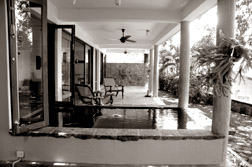
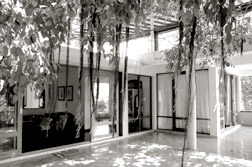
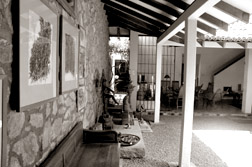
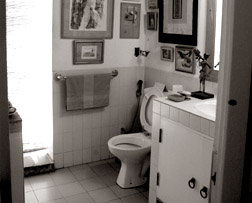
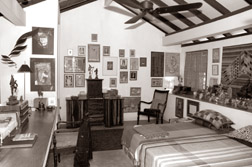
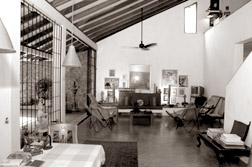
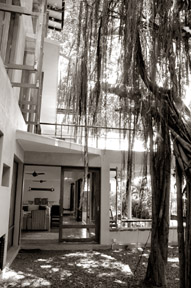 Geoffrey Bawa was a Sri Lankan architect-enthusiast who travelled far
and wide and had seen almost all the monumental work belonging to
diverse architectural traditions. After extensive travelling, a largely
self-educated Bawa returned to Sri Lanka and designed his garden, the
now-famous 'Bawa's Garden', a utopian garden at his estate Lunugaga
giving free reign to his unbounded imagination.
Geoffrey Bawa was a Sri Lankan architect-enthusiast who travelled far
and wide and had seen almost all the monumental work belonging to
diverse architectural traditions. After extensive travelling, a largely
self-educated Bawa returned to Sri Lanka and designed his garden, the
now-famous 'Bawa's Garden', a utopian garden at his estate Lunugaga
giving free reign to his unbounded imagination. 







